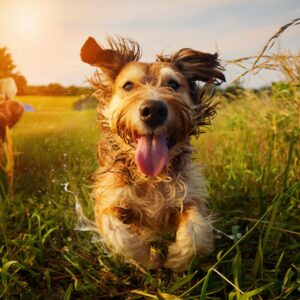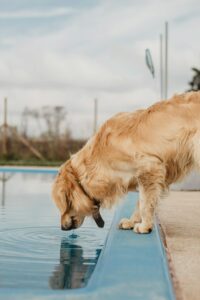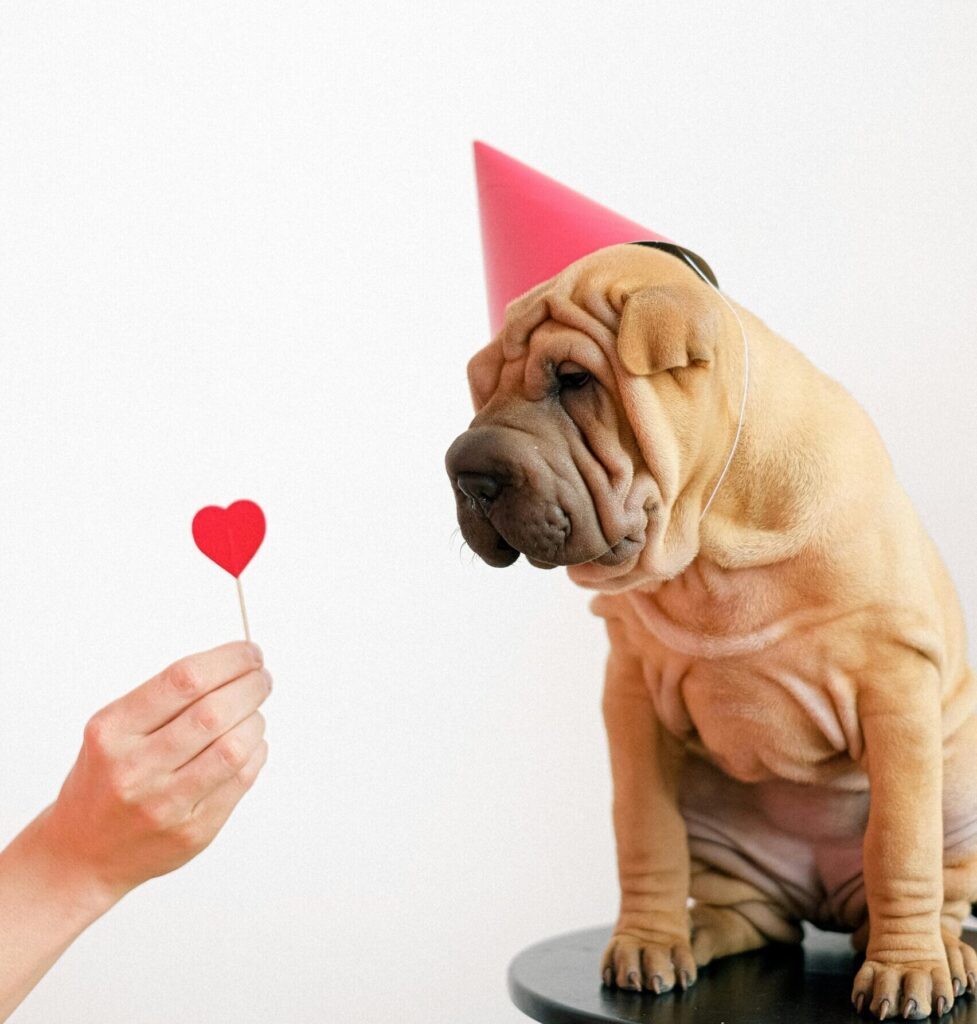Hydration is a critical aspect of maintaining the health and well-being of our beloved canine companions. Just like in humans, water plays a vital role in the proper functioning of a dog’s body. Below, we’ll explore the importance of hydration in dogs, key points to ensure your dog is adequately hydrated, and some final considerations based on your pet’s breed and size.
1- Importance of hydration in dogs:
- Body Temperature Regulation:Dogs regulate their temperature by panting and sweating through their paw pads. Adequate hydration is crucial to this process, especially in hot weather or during intense exercise.
- Cellular Function:Water is essential for transporting nutrients to cells and removing waste from the dog’s body.
- Kidney Health:Proper hydration helps prevent kidney problems and urinary stones by keeping the kidneys in good working order.
- Digestion and Nutrient Absorption:Water facilitates the digestion process and the absorption of nutrients in the gastrointestinal tract of dogs, contributing to optimal digestive health.
- Skin and Coat Health:Good hydration promotes healthy skin and a shiny coat in dogs, preventing dryness and skin irritation.
- Preventing Fatigue and Exhaustion:Dogs that are well hydrated have more energy and stamina, allowing them to enjoy physical activities and play for longer without becoming fatigued.
- Brain Function:Water is crucial for maintaining proper brain function in dogs, which influences their ability to learn, remember, and respond to environmental stimuli.
- Heat Stroke Prevention:Dehydration increases the risk of heat stroke in dogs, a potentially life-threatening condition. Maintaining proper hydration is critical to preventing this risk, especially in hot climates.
- Increased Longevity:Proper hydration contributes to the overall health and longevity of dogs, helping to prevent diseases related to dehydration and premature aging.
- General Wellbeing:Keeping your dog hydrated is essential for their overall wellbeing and quality of life, allowing them to fully enjoy every moment with their human family.
2- 10 Tips to Make Sure Your Dog is Hydrated:
- Fresh, Available Water at All Times: Make sure your dog has constant access to fresh, clean water at all times.
- Watch for Signs of Dehydration: Watch for signs such as lethargy, dry gums, loss of skin elasticity, and thick saliva, which can indicate dehydration in your dog.
- Monitor Exercise Intensity: During intense exercise or on hot days, increase the water supply and allow frequent breaks so your dog can properly hydrate.
- Offer Wet Food: If your dog primarily eats dry food, consider supplementing his diet with wet food or adding water to his kibble to increase his fluid intake
Discover Toxic and Safe Foods for your dogs. - Avoid Prolonged Sun Exposure: Limit your dog’s exposure to the sun during the hottest hours of the day and provide shaded areas and fresh water to help him stay hydrated.
- Monitor Urination: Observe the frequency and color of your dog’s urine. Frequent, light-colored urination indicates good hydration, while dark, concentrated urine can be a sign of dehydration.
- Consider Size and Breed: Larger, more active breeds, as well as long-haired dogs , may require more water to stay hydrated compared to smaller or less active breeds.
- Offer Fresh Water During Travel: If you are traveling with your dog , bring fresh water and a bowl for him to drink during the trip and during stops.
- Consult with your Veterinarian: Always consult with your veterinarian if you have concerns about your dog’s hydration or if you notice unusual changes in his behavior or health.
- Educate Your Family: Make sure all members of your family, including children, understand the importance of keeping your dog properly hydrated and are committed to his well-being
READ MORE
3- Final considerations according to the breed and size of the dog:
- Small Breeds: Small breed dogs can become dehydrated more quickly due to their smaller size, so it is important to provide them with water regularly and watch for signs of dehydration .
- Large Breeds: Large breed dogs have higher water needs due to their size and activity level, so it is crucial to ensure they have access to plenty of fresh water at all times.
- Long-Haired Dogs: Breeds with long coats may be more susceptible to overheating and dehydration, as their fur can make it difficult to regulate body temperature. Make sure to provide them with a cool environment and plenty of water to help them stay hydrated.
- Working or Sporting Dogs: Dogs that participate in sporting or working activities, such as hunting or herding, may require additional hydration due to intense physical exertion. Provide frequent access to fresh water and allow regular breaks during activity so they can replenish fluids.
4- Special care during the summer:
Summer and hot days present additional challenges to keeping dogs properly hydrated and cool. Here are some special considerations to ensure your dog ‘s well-being during these times:
- Extra Hydration: During the summer, increase the amount of water your dog provides, especially during the hottest hours of the day. Consider adding ice cubes to the water to keep it cooler longer.
- Avoid Strenuous Exercise During Peak Heat: Limit vigorous exercise and outdoor activities during peak heat hours, such as midday. Opt for walks in the early morning or cooler evenings to avoid the risk of overheating.
- Provide Shade and Cool Places: Make sure your dog has access to shaded, cool areas where he can rest during the day. Avoid leaving him in areas exposed to the sun for long periods of time.
- Protecting Paw Pads: Hot surfaces like asphalt can burn your dog ‘s paw pads . Choose walks in shaded areas or cool grass, or use protective booties if necessary.
- Refreshing Baths: Provide your dog with refreshing baths with cool water to help keep him cool and comfortable during hot days. You can also consider small pools or water features to help him cool off.
- Prevent Heat Stroke: Know the signs of heat stroke in dogs , which include excessive panting, weakness, vomiting, and collapse. If you suspect your dog is experiencing heat stroke, seek veterinary attention immediately.
-
-
-
-
-
-
-
-
- Adjust Diet: During the summer, consider adjusting your dog ‘s diet to include foods with high water content, such as fresh fruits and vegetables. This can help increase his fluid intake and keep him hydrated.
- Caution for Vulnerable Breeds: Some breeds, such as brachycephalic (short-nosed) dogs like Bulldogs or Pugs, are more susceptible to heat due to their facial features. Keep them in cool environments and closely monitor any signs of discomfort.
- Safe Travel: If you travel with your dog during the summer, make sure the vehicle is well ventilated and never leave your dog inside a parked car, even for short periods of time, as the temperature inside the car can quickly rise and cause heat stroke.
- Consult with your Veterinarian: Always consult with your veterinarian for specific advice on caring for your dog during the summer, especially if you live in areas with high temperatures or your dog has pre-existing health conditions that may be affected by the heat.
-
-
-
-
-
-
-
-
By following these special precautions during the summer or in hot climates, you can ensure that your dog is comfortable, safe and well hydrated, allowing him to enjoy the summer season to the fullest with you.
READ MORE ON HOW SUMMER HEAT AFFECT DOGS








